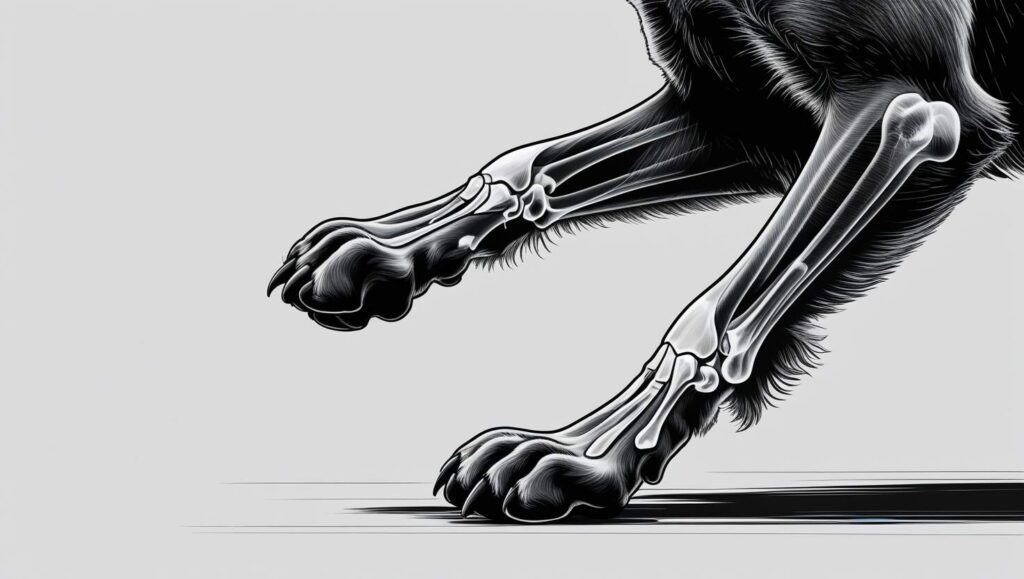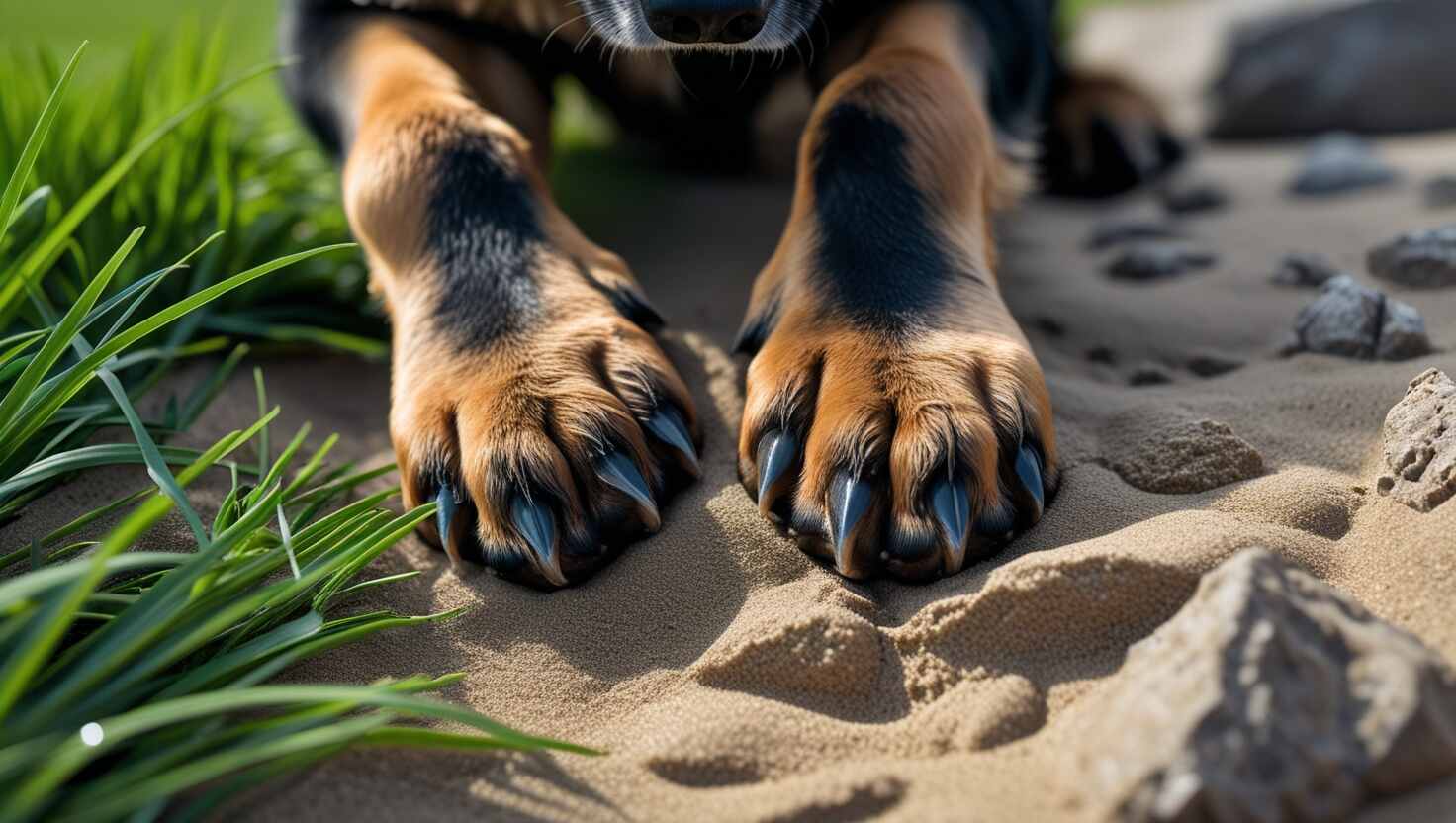Do German Shepherds Have Webbed Feet?

German Shepherds do not have fully webbed feet like water breeds but have slight webbing that aids in traction and stability on rough terrains. Their paws are built for agility, endurance, and protection rather than swimming. While some may show minor webbing due to genetics, it does not impact their working abilities.
Do German Shepherds Have Slightly Webbed Paws?
German Shepherds do not have fully webbed feet like some breeds such as Labradors or Newfoundlands. However, they do have a slight amount of webbing between their toes, which helps with traction, stability, and agility on rugged or slippery surfaces. This feature is not as pronounced as in water breeds, but it still aids in performance, especially when navigating icy, snowy, or rough terrains.
How Large Are German Shepherd Paws?
A German Shepherd’s paws are medium-sized but appear large compared to some breeds due to their strong, well-arched structure. Their width allows for greater stability, while their pads provide remarkable traction on various terrains. On average, their paw size ranges between 8 to 10 centimeters (3 to 4 inches) in length and width, depending on their genetics and physical development. Male GSDs generally have larger paws than females.
What Are the Distinct Features of German Shepherd Paws?
A German Shepherd’s paws have distinct characteristics that reflect their breed’s versatility. Their toes are arched, giving them a stable stance, while their thick, coarse pads act as natural shock absorbers. The black nails are strong, helping them maintain grip while running or climbing. The pads are thick and textured, allowing them to withstand the pressure of varied terrains, from snow to hard surfaces. Their paw shape contributes to their dynamic gait and efficient movement.
How Sensitive Are German Shepherd Paws?
Despite their rugged appearance, German Shepherd paws have a high concentration of nerves, making them sensitive to textures, temperatures, and surrounding elements. Their pads contain nerve-endings that help them detect changes in the ground, enabling quick response in various environments. While their thick padding provides protection, their sensitivity makes them prone to injuries from hot pavement, sharp objects, or rough terrains.
Do German Shepherds Benefit from Their Slight Webbing?

Although German Shepherds are not bred for swimming, their paws do have a slight webbing between their toes, which serves a functional purpose. This webbing assists in navigating wet, slippery, or unstable surfaces, allowing them to maintain balance and agility. Unlike water breeds, their webbing is not extensive, but it still contributes to their stability when running, climbing, or maneuvering through challenging terrains.
Webbing in German Shepherd Feet: A Rare Trait
Some German Shepherds have slightly webbed feet, but this is a rare trait and not part of the official breed standards. Unlike breeds such as the Labrador Retriever, which are bred for swimming and wetlands, a GSD’s webbing is usually minimal and does not impact their working roles. However, historical breeding has led to some individuals exhibiting more webbing, possibly due to interbreeding with other breeds at some point in their bloodline. This genetic diversity allows for variations in traits, sometimes making the webbing more visible in certain offspring.
The Unique Structure of German Shepherd Paws

The structure of a German Shepherd’s paws is built for versatility across different terrains. Their rounded toes are arched and closed, providing stability while maneuvering through rocky hills, muddy fields, and snowy regions. Their pads are thick and cushioned, acting as a protective barrier against sharp stones, lodged objects, and icy surfaces. Their short, strong, dark nails enhance grip, preventing slipping on slippery landscapes, snowy operations, and wet environments. This adaptation is particularly useful in regions where snow accumulation is common, reducing the risk of frostbite and allowing them to navigate difficult landscapes efficiently.
Why Some German Shepherds Exhibit Webbing
Some breeders focus on selecting individuals that can efficiently work in demanding environments, ensuring they are equipped to handle strenuous tasks such as rescue, police operations, herding livestock, and hunting in wetlands. Due to genetic diversity, webbing may occasionally appear due to recessive genes being recombined over generations. Though not a dominant trait, it can sometimes be recognized in certain mixed-lineage German Shepherds, where crossbreeding with water breeds has occurred.
Benefits of Slight Webbing in Certain Conditions
Though not standard, the presence of slight webbing can offer advantages in marshy lands, wet environments, and snowy terrains. It improves traction, balance, and protection against accumulating debris while preventing injury from twisting movements. This is particularly helpful when moving through soggy meadows, pastures, icy hillsides, or rocky grounds, where stability is crucial.
The Role of Paws in Adaptation and Survival
A German Shepherd’s true capabilities lie in their agility, intelligence, and dexterity, allowing them to efficiently handle various challenges. Their paw structure plays a key role in heat distribution, cooling, and thermoregulation, helping them to avoid overheating in hot climates. Unlike aquatic breeds with flipper-like feet, their pads function to dissipate heat and maintain comfort in differing temperatures. Additionally, their broader toes help them scoop dirt and sand while digging, an instinctual behavior that has persisted across generations. Their paws also serve as a protective base, shielding them from sharp underbrush, stones, and rough surfaces, making them a versatile breed suited for demanding duties.
Webbing in Purebred German Shepherds

Purebred German Shepherds do not have prominent webbed feet, as it is not part of the breed standard set by the American Kennel Club. Their compact, short feet with good arch and thick, firm paw pads help them maintain stability on slick and uneven terrains. Unlike a Labrador Retriever, which has connective skin between the toes for swimming, a German Shepherd’s anatomy is shaped by its historical role in herding, search and rescue, and police work.
A DNA test can confirm a German Shepherd’s lineage, ensuring its registration paperwork aligns with breed standards. While some unusual cases may show slight webbing, this is not a sign of a health condition. Their short, dark nails provide grip, and their weight distribution supports agility, endurance, and dexterity in rugged environments. Their evolutionary adaptation makes them fit for marshy and snowy terrains, assisting in their versatility as working dogs without needing surgery for any webbing-related concerns.
Advantages of Webbed Feet in Some German Shepherds
Although purebred German Shepherds are not known for webbed feet, slight connective skin between their toes can offer beneficial features. Unlike Newfoundland Retrievers, which are strong swimmers, a German Shepherd’s evolutionary adaptation focuses on herding, police work, and search and rescue rather than aquatic prowess. However, in rugged terrains, webbing may provide extra grip, especially on slick, rocky, or muddy surfaces, improving their balance and stability in uneven climates.
For active working dogs, webbing may also help in digging through snow accumulation or preventing sinking in soft, muddy terrain. This adaptation enhances mobility by pushing forward with ease, making movement more efficient in cold or marshy conditions. A broader surface area improves traction, reducing strain on the firm paw pads during high-energy tasks.
Though not a breed standard recognized by the American Kennel Club, slight webbing does not indicate a health condition. A veterinarian can assess if the feature affects comfort, but generally, German Shepherds with minor webbing remain fit, healthy, and perform their historical roles with resilience and dexterity.
Does a German Shepherd Need Webbed Feet?
Most purebred German Shepherds do not have webbed feet, and this does not affect their health, mobility, or quality of life. Their compact, short feet with a good arch, thick, firm paw pads, and short, dark nails provide excellent grip on rocky, muddy, or snowy terrains. Unlike Newfoundland Retrievers, which rely on web-like features for swimming, German Shepherds are working dogs bred for herding, police work, and search and rescue.
A vet checkup can help determine if a German Shepherd’s anatomy aligns with breed standards set by the American Kennel Club. Webbing is not required for their efficiency in active lifestyles or house companions. Their evolutionary adaptation focuses on strength, stability, and dexterity, making them well-suited for pushing forward in rugged environments. Keeping their toes separate helps prevent yeast and bacteria buildup, ensuring they stay healthy, happy, and clean while they play and walk in different climates.
Webbed Feet and Their Functionality
Webbed Feet on Land
Unlike retrievers or other swimmers, purebred German Shepherds have short feet with thick, firm paw pads, which provide excellent traction on rocky, muddy, or uneven ground. Their toes are compact with a good arch, allowing for stability, dexterity, and agility in demanding terrains. This evolutionary adaptation helps them excel in herding, police work, and search and rescue operations. Their historical role as working dogs required strength and balance rather than enhanced surface area for swimming. While their connective skin does not form a strong web-like structure, it still provides support on slick and marshy ground, preventing sinking and ensuring mobility in various climates.
Swimming and Webbed
Although German Shepherds are not natural swimmers, their functional anatomy allows them to navigate aquatic environments when needed. Their feet lack the broad webbed structure seen in Newfoundlands or Labrador Retrievers, but their paws still offer some grip in snowy, muddy, or soft terrains. With proper training, they can develop efficiency and quickness in water, though their weight distribution makes them less suited for prolonged swimming. Owners should monitor their paws for mud, yeast, and bacteria buildup after water activities and schedule a vet checkup if any health conditions arise. Whether assisting in rescue, adapting to an active lifestyle, or simply at play, keeping their feet clean ensures a happy, healthy, and fit companion.
The Evolutionary Purpose of Webbed Feet
Ancient Roots
Purebred German Shepherds have a rich ancestry rooted in herding, guarding, and police work. Their evolutionary design was shaped for strength, stability, and endurance rather than swimming. Unlike Labrador Retrievers or Newfoundlands, they do not have fully webbed feet, but their compact, short feet, good arch, and thick, firm paw pads help them move efficiently across rocky, muddy, and uneven terrains. Their historical role required them to navigate rugged landscapes, making their foot structure a crucial part of their adaptation.
Agile Adventurers
With their dexterity, agility, and balance, German Shepherds excel in agility training, quick turns, and pushing forward on slick ground. Their connective skin between the toes provides minor grip, which is beneficial for traction on snowy or muddy terrain. Whether running, digging, or performing search and rescue work, their functional anatomy supports an active lifestyle. Their weight distribution also prevents sinking in soft ground, making them versatile across different climates.
Swim-tastic Skills
Though not natural swimmers, some German Shepherds enjoy a refreshing dip near water sources. Their anatomy does not provide the broader surface area that makes retrievers great at water sports, but they can still learn to swim with training. Owners should determine their pet’s comfort in water and ensure their paws stay clean to avoid yeast, bacteria, and mud buildup. A vet checkup is required if any issues arise that could affect their quality of life, ensuring they stay healthy, fit, and happy whether as a show dog, companion, or house pet.
Comparison with Other Dog Breeds
Webbed Feet in Other Breeds
Some breeds have webbed feet that improve their swimming ability and performance in aquatic tasks. These include:
- Labrador Retrievers, New found lands, and Leonbergers – Known as powerful swimmers, their connective skin between the toes provides better traction in water, making them excellent for water rescue.
- St. Bernards and Great Pyrenees – While not swimmers, their slight webbing helps them move through snowy and rugged terrains by preventing sinking in soft snow.
- Herding dogs like German Shepherds – Their evolutionary design favors grip, stability, and dexterity on rocky, muddy, and uneven ground rather than efficient movement in water.
Unlike New found lands, purebred German Shepherds have compact, short feet with a good arch, thick, firm paw pads, and dark nails for balance on varied terrains. Their historical role in herding, police work, and search and rescue relied on strength, endurance, and quick turns, rather than enhanced webbing for swimming.
For owners concerned about unusual foot structure, a DNA test can determine if a German Shepherd meets the breed standard set by the American Kennel Club. Regular vet checkups help detect health conditions affecting mobility. Keeping their paws clean prevents yeast, bacteria, and mud buildup, ensuring they stay healthy, fit, and happy whether as a show dog, companion, or house pet.
Fused Toes vs. Webbed Feet
Some canine breeds, like the Labrador Retriever, have webbed feet as an evolutionary adaptation for aquatic movement. However, German Shepherds do not have this phenomenon. Instead, they have distinct digits with a small membrane of skin between them, which is different from syndactyly, a rare anomaly where toes are fused together due to a genetic mutation.
Studies on skeletal structure and breed identification show that German Shepherds’ feet are built for terrain navigation, not swimming. Their foot function is optimized for work, including police tasks and herding, rather than for surface area in water. Experts suggest that this distinction in evolution comes from their ancient lineage, which prioritized movement over aquatic abilities.
While some modifications in bone structure can appear due to genetic alterations, they are rare and not part of the breed standard. In extreme cases, surgical intervention may be needed if a serious issue affects a dog’s mobility. However, this is an uncommon occurrence, and most German Shepherds remain highly efficient in their natural work environments.
Common Paw-Related Concerns in German Shepherds

German Shepherds are built for stability and rugged terrain, but they can face certain paw issues that affect their mobility. Some common concerns include:
- East-West Feet – Some puppies may have turned-out paws instead of a compact, rounded stance. This trait may improve with exercise, diet, and strong ligaments and muscles, but in extreme cases, it can cause joint complications in adulthood.
- Knuckling and Dragging – This can be linked to nerve damage, degenerative myelopathy, or peripheral neuropathy. These conditions cause muscle weakness, affecting the dog’s gait and efficiency. Early detection and check-ups can help slow the disease, but severe cases have no complete reversal.
- Paw Irritation and Allergies – Climates, salty surfaces, or reactions to footwear can cause itching and irritation between the nails and paw structure. Regular observation helps ensure comfort and prevents long-term degenerative issues.
Researchers and enthusiasts emphasize awareness to maintain a German Shepherd’s lifetime performance and loyalty as a working breed.
Conclusion
While German Shepherds lack full webbing like swimming breeds, their paws are designed for agility, stability, and traction on rough terrain. Their evolutionary adaptation supports their functional role in herding and protection, making them paw some companions in various environments.
Through research and exploration, canine enthusiasts appreciate the uniqueness of this breed and its remarkable abilities. Whether purebred or non-purebred, their characteristics reflect an intriguing history shaped by environmental needs and genetics. Their toes and paws are built for practicality, not swimming, adding to their distinction and ongoing admiration.
Kindly note: The content shared in this blog is gathered from online sources, some of which may not be verified. For accurate guidance on caring for your dog, it is recommended to seek advice from a qualified veterinarian.
Frequently Asked Questions
Can purebred German Shepherds have webbed feet?
A: No, purebred German Shepherds do not have fully webbed feet like some canine breeds. However, they have a slight degree of connective skin between their toes, which helps with stability on rough terrain.
Do German Shepherds like to swim?
A: Some may enjoy swimming, but it depends on their preference and introduction to water. A positive experience can make it a delightful and refreshing activity for them.
Can German Shepherds swim?
A: Yes, they can learn to swim, but they are not natural swimmers. With patience, safe training, and proper understanding, they can develop enjoyment in splashing around.
Are all dogs web-footed?
No, only certain breeds have pronounced webbing as an adaptation for water. German Shepherds have unique features that make them stand out in other activities.

